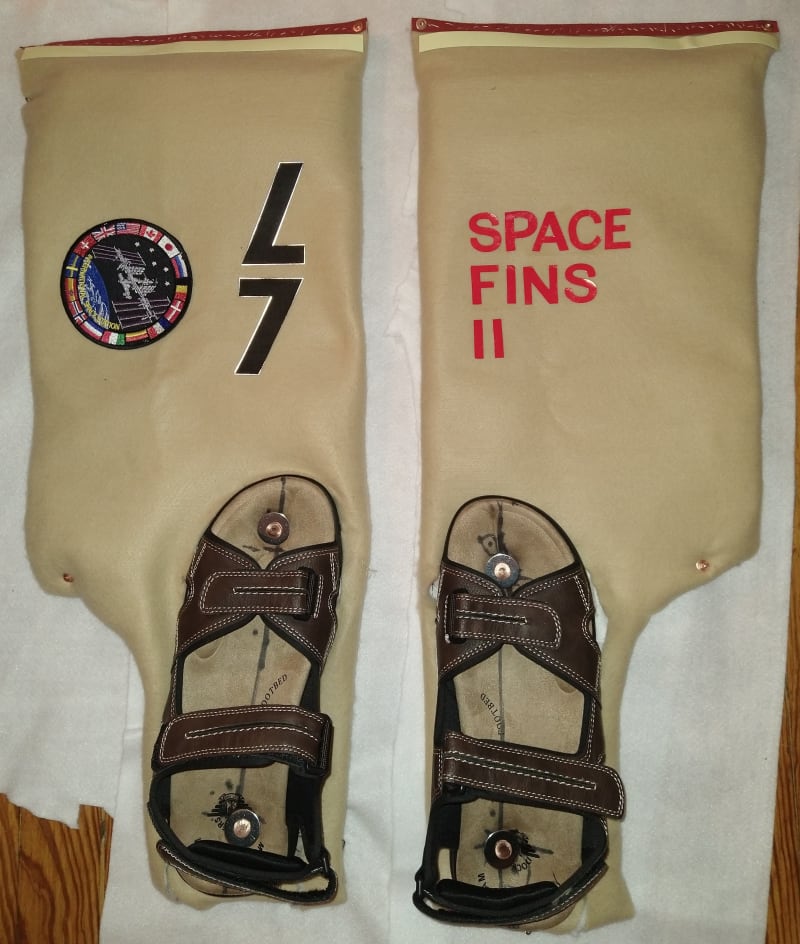Astronauts in weightlessness, inside of a large pressurized habitat, can be self-propelled through the cabin air WITHOUT pushing off against any object. A slipper-like variant of swimfins displaces cabin air to push them forward on their own power (CTF 2023 Holmin).
Prototype has flexible plastic core sheet adhered to rubber soles of strap sandle foot-holders, which are anchored with burr-rivets, and reinforced with a steel plate and washers.. One pound soft ankle weights are burr-riveted directly to core sheet ends (Figure One).
Each fin is 11 inches wide x 27 inches long and weighs 2.5 pounds.
Prototype tore itself apart and required reinforcement. Also unusually hard to balance: Designed for microgravity not Earth gravity!
Production model could integrate components in soft, molded and reinforced silicone with embedded weighting pellets, Could market core sans covering as an improved diving fin.
Inventor experienced fatigue and even minor muscle strains from testing first prototype (Holmin CTF 2023). Could apply swim fin tech such as an offset fin blade angle to relieve muscle fatigue.
The first prototype pair DID spin my mulish pinwheel test stand by their flapping, but only very poorly (CTF 2023 Holmin). In fact, they were soundly “beaten” by an undulating sheet of copy paper!
Fins are fanned up and down in alternating fin kicking motion. Blade weights swing opposite each other, further increasing efficient motion. Weighted-end fin blades are now spring pendulum: They use inertia to turn fins into a spring-assisted flapping machine, ensuring clean strokes in thin cabin air (or water), and multiplying output of users’ leg kicks (Figure Two).
Flapping of their blades uses inertia of the edge weights as well as the springy flexible core sheet of the fins. Unlike swim fins, air does not resist the fins to help them to flex and snap back with each stroke. The revised weighted edge design becomes effectively a free-articulated spring pendulum. To stop flapping in microgravity, a handhold may be grabbed and Fins pressed against a stationary deck or bulkhead or each other.
Aquatic version might help overcome water resistance and multiply force with each snap of the fin blades’ weighted edges. So the fins’ pendulous flapping acts like a spring assist to the feet and legs, reducing fatigue. Could be marketed as Sky Fins/Sea Fins.
Some habitats may be too cramped to use the fins. In a very large volume, as found in the old Skylab orbital station or the future SpaceX Starship, there would be ample room. The Fins may be worn for recreation and exercise as well as for safety and utility.
Improved prototype has larger surface area and is covered in beige felt with soft batting (Figure Three). Fireproof Nomex felt may be used for spaceflight model, and feature quick release foot holders. They have stitched web edges, with glow in the dark stripes and a number for emergency visibility (Video). Decorated with an International Space Station flight patch bearing the flags of fifteen nations cooperating peacefully in Earth orbit.
Video
Like this entry?
-
About the Entrant
- Name:Leonard J Holmin
- Type of entry:individual
- Patent status:none

